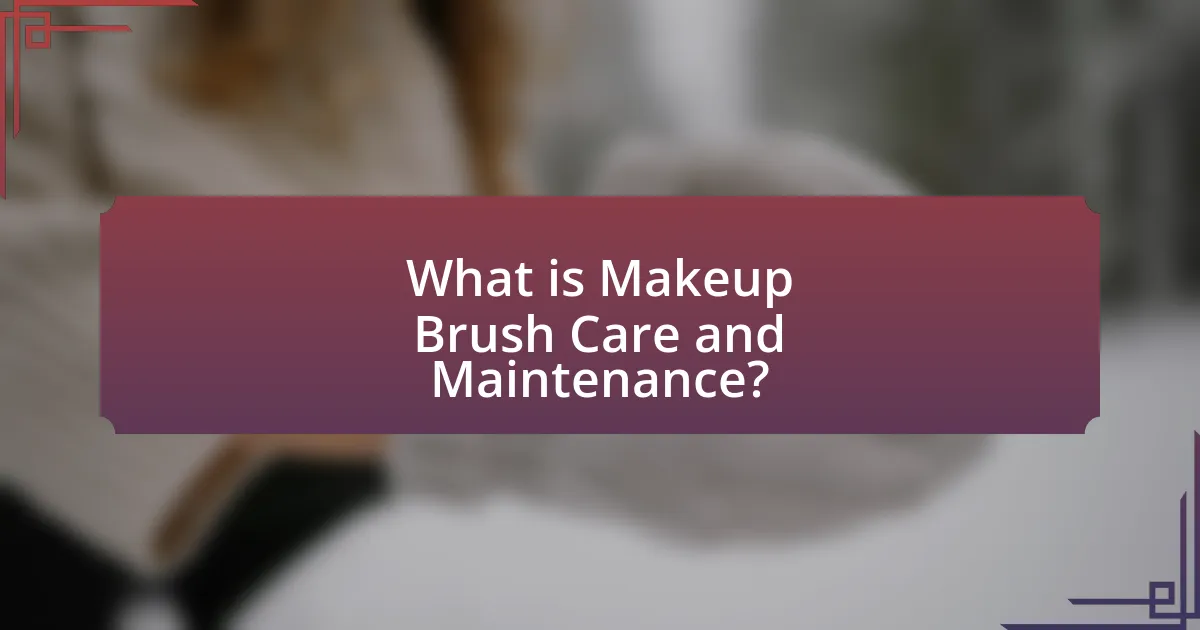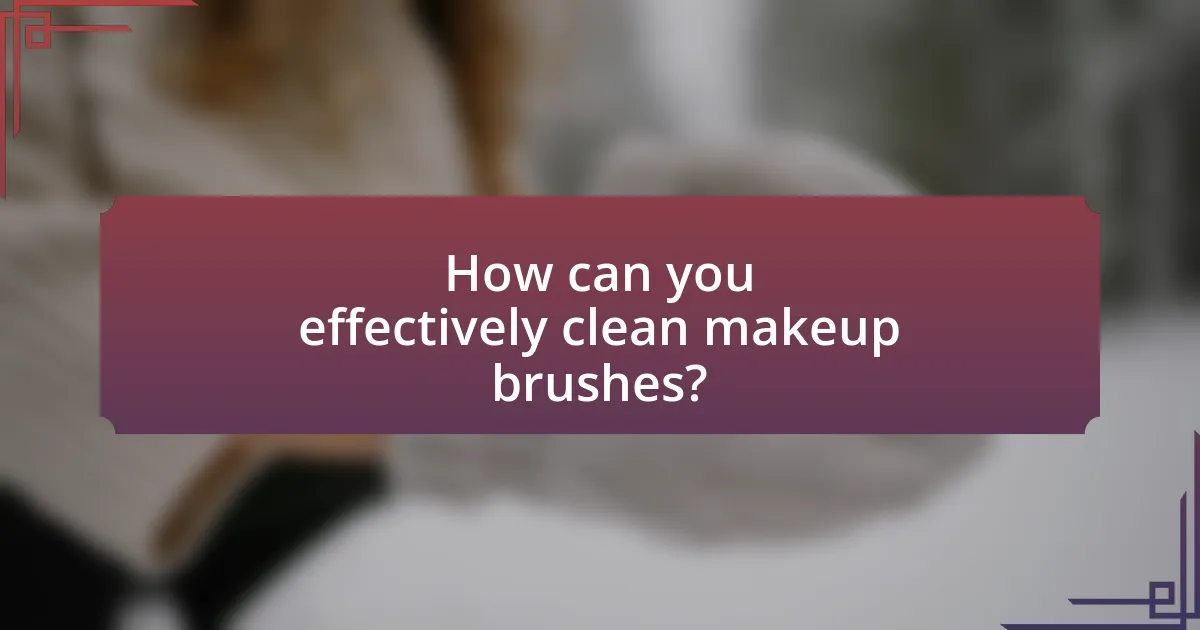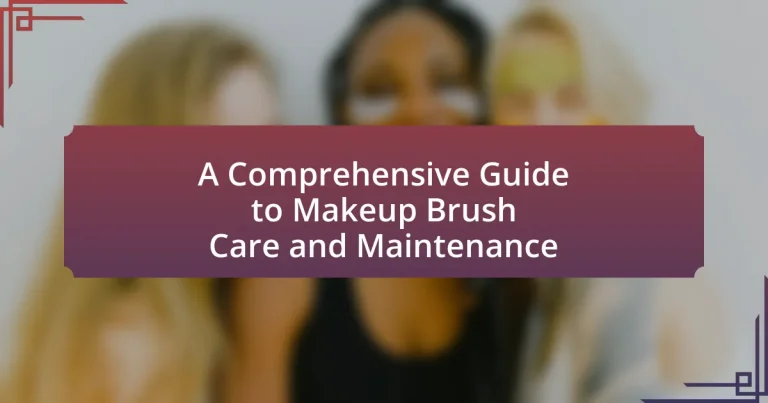Makeup brush care and maintenance is essential for ensuring the longevity and effectiveness of brushes used in makeup application. Regular cleaning, recommended at least once a week, removes bacteria, oils, and product buildup, which can lead to skin irritations and affect makeup results. Proper storage techniques, such as keeping brushes upright, help maintain their shape and prevent damage. The article covers the importance of brush hygiene, the consequences of neglecting maintenance, specific care requirements for different brush materials, effective cleaning methods, and best practices for storage, ultimately emphasizing how these practices enhance makeup application and promote healthier skin.

What is Makeup Brush Care and Maintenance?
Makeup brush care and maintenance involves the regular cleaning and proper storage of makeup brushes to ensure their longevity and effectiveness. Regular cleaning removes product buildup, bacteria, and oils, which can affect makeup application and skin health. It is recommended to clean brushes at least once a week using a gentle cleanser or brush soap, followed by thorough rinsing and air drying. Proper storage, such as keeping brushes upright in a holder, prevents bristle damage and maintains their shape. These practices help maintain the quality of the brushes and promote better hygiene, ultimately enhancing makeup application results.
Why is it important to care for makeup brushes?
Caring for makeup brushes is important to maintain their performance and hygiene. Regular cleaning prevents the buildup of bacteria, which can lead to skin irritations and breakouts. Additionally, well-maintained brushes ensure even application of makeup, enhancing the overall look. Studies indicate that dirty brushes can harbor harmful pathogens; for instance, a study published in the Journal of Cosmetic Dermatology found that 90% of tested brushes contained bacteria. Therefore, proper care not only extends the lifespan of the brushes but also promotes healthier skin and better makeup results.
What are the consequences of neglecting brush maintenance?
Neglecting brush maintenance leads to the accumulation of bacteria, which can cause skin irritations and breakouts. Dirty brushes harbor oils, dead skin cells, and makeup residue, creating an environment conducive to bacterial growth. Studies indicate that using unclean brushes can transfer these harmful substances to the skin, increasing the risk of acne and other skin conditions. Additionally, neglecting maintenance can result in decreased brush performance, as bristles become matted and less effective at applying makeup evenly. This ultimately affects the quality of makeup application and can lead to wasted products.
How does proper care enhance makeup application?
Proper care enhances makeup application by ensuring that tools are clean, effective, and long-lasting. Clean brushes prevent the transfer of bacteria and oils, which can lead to skin irritation and uneven application. Regular maintenance, such as washing brushes with appropriate cleansers, removes product buildup and maintains bristle integrity, allowing for smoother and more precise makeup application. Studies show that using clean brushes can improve the overall finish of makeup, as they apply products more evenly and blend seamlessly, resulting in a polished look.
What types of makeup brushes require care?
All types of makeup brushes require care, but specific attention is needed for natural hair brushes, synthetic brushes, and specialty brushes like stippling or fan brushes. Natural hair brushes, made from animal fibers, absorb oils and products, necessitating regular cleaning to maintain their shape and performance. Synthetic brushes, often used for liquid products, also require cleaning to prevent product buildup and maintain hygiene. Specialty brushes, such as stippling brushes for airbrushed effects or fan brushes for highlighting, need careful maintenance to preserve their unique shapes and functionality. Regular cleaning and proper storage are essential for all these brush types to ensure longevity and optimal performance.
How do different brush materials affect maintenance needs?
Different brush materials significantly influence maintenance needs due to their varying durability, cleaning requirements, and susceptibility to damage. For instance, synthetic brushes typically require less maintenance than natural hair brushes because they are more resistant to product buildup and can be cleaned easily with soap and water. In contrast, natural hair brushes demand more careful handling and specific cleaning methods to preserve the integrity of the hair, as they can absorb oils and moisture, leading to potential damage if not maintained properly. Additionally, synthetic fibers tend to dry faster, reducing the risk of mold and bacteria growth, while natural fibers may require more time to dry and can be prone to such issues if not dried correctly. Therefore, the choice of brush material directly correlates with the frequency and type of maintenance required to ensure optimal performance and longevity.
What are the specific care requirements for natural vs. synthetic brushes?
Natural brushes require gentle cleaning with mild soap and water, while synthetic brushes can be cleaned with a wider range of cleansers, including alcohol-based products. Natural brushes, made from animal hair, are more susceptible to damage from harsh chemicals and should be dried flat to maintain their shape. In contrast, synthetic brushes, made from nylon or polyester, are more durable and can withstand rigorous cleaning methods. Regular cleaning of both types is essential to prevent product buildup and bacteria growth, ensuring longevity and performance.

How can you effectively clean makeup brushes?
To effectively clean makeup brushes, use a gentle cleanser or soap specifically designed for brushes, warm water, and follow a systematic cleaning process. Begin by wetting the bristles under lukewarm water, ensuring the water does not reach the ferrule, as this can loosen the glue. Apply a small amount of cleanser to the bristles and gently lather, using circular motions to remove makeup residue. Rinse thoroughly until the water runs clear, then reshape the bristles and lay the brushes flat to dry. Regular cleaning is essential, as studies show that unclean brushes can harbor bacteria, leading to skin issues.
What are the best methods for cleaning brushes?
The best methods for cleaning brushes include using gentle soap or brush cleaner, warm water, and proper rinsing techniques. To clean brushes effectively, first, wet the bristles with warm water, then apply a small amount of gentle soap or specialized brush cleaner to the bristles. Gently lather and work the soap into the bristles, ensuring not to submerge the ferrule (the metal part) in water, as this can loosen the glue. Rinse the bristles under warm running water until the water runs clear, then reshape the bristles and lay the brush flat to dry. This method is supported by recommendations from professional makeup artists, who emphasize that regular cleaning prevents bacteria buildup and prolongs the life of the brushes.
How do you use soap and water for brush cleaning?
To clean brushes using soap and water, first wet the bristles under lukewarm running water, ensuring the water does not reach the ferrule to prevent loosening the glue. Next, apply a small amount of gentle soap, such as baby shampoo or dish soap, to the bristles and gently lather by swirling the brush in the palm of your hand or on a clean surface. Rinse the bristles thoroughly under running water until the water runs clear, indicating that all soap and makeup residue have been removed. Finally, reshape the bristles and lay the brush flat on a clean towel to dry. This method effectively removes dirt and bacteria, maintaining the brush’s integrity and performance.
What are the benefits of using brush cleansers?
Using brush cleansers effectively removes makeup residue, bacteria, and oils from brushes, ensuring better hygiene and performance. Regular use of brush cleansers helps maintain the integrity of brush bristles, prolonging their lifespan and preventing damage. Additionally, clean brushes enhance makeup application, resulting in a smoother and more even finish. Studies indicate that using proper brush cleansers can reduce the risk of skin irritation and breakouts caused by bacteria buildup, thus promoting healthier skin.
How often should you clean your makeup brushes?
You should clean your makeup brushes at least once a week. Regular cleaning prevents the buildup of bacteria, which can lead to skin irritation and breakouts. According to a study published in the Journal of Cosmetic Dermatology, unclean brushes can harbor harmful bacteria, emphasizing the importance of weekly maintenance for skin health.
What factors influence the frequency of cleaning?
The frequency of cleaning makeup brushes is influenced by several key factors, including usage frequency, type of makeup applied, and skin type. Regular use of brushes for liquid or cream products necessitates more frequent cleaning to prevent product buildup and bacterial growth. For instance, brushes used daily may require cleaning once a week, while those used less frequently can be cleaned bi-weekly. Additionally, individuals with oily or acne-prone skin should clean their brushes more often to avoid transferring oils and bacteria onto the skin, which can exacerbate breakouts. Research indicates that proper brush hygiene can significantly reduce the risk of skin irritation and infections, underscoring the importance of these factors in determining cleaning frequency.
How can you establish a cleaning routine?
To establish a cleaning routine for makeup brushes, first determine a consistent schedule, such as weekly or bi-weekly, to clean the brushes. This frequency helps prevent the buildup of bacteria and ensures optimal performance of the brushes. Research indicates that regular cleaning can significantly reduce the risk of skin irritation and breakouts caused by dirty brushes. For effective cleaning, use a gentle soap or brush cleaner, and rinse thoroughly to remove all residue. Following this routine will maintain brush hygiene and prolong their lifespan.

What are the best practices for storing makeup brushes?
The best practices for storing makeup brushes include keeping them in a clean, dry environment, ideally in a holder that allows them to stand upright. This prevents bristles from becoming misshapen and reduces the risk of bacteria growth. Additionally, storing brushes away from direct sunlight and humidity helps maintain their quality and longevity. Using a brush roll or a dedicated makeup organizer can also protect brushes from dust and damage. Regularly cleaning the storage container is essential to ensure a hygienic environment for the brushes.
How should you store brushes to maintain their shape?
To maintain the shape of brushes, store them upright in a holder or container with the bristles facing up. This prevents the bristles from bending or becoming misshapen, which can occur if brushes are laid flat or stored in a way that compresses the bristles. Additionally, using a brush roll or case can provide protection and organization, further preserving their shape. Proper storage is essential, as studies show that maintaining the integrity of brush bristles enhances their performance and longevity.
What storage options are available for makeup brushes?
Makeup brushes can be stored in various ways, including brush holders, cases, and organizers. Brush holders, such as cups or jars, allow for easy access and visibility, while cases provide protection and portability. Organizers, which can be drawer inserts or acrylic containers, help keep brushes separated and dust-free. These storage options not only maintain the brushes’ shape and hygiene but also extend their lifespan by preventing damage.
How does the environment affect brush storage?
The environment significantly affects brush storage by influencing factors such as temperature, humidity, and exposure to light. High humidity can promote mold and mildew growth on brushes, while extreme temperatures can warp or damage the bristles and handles. Additionally, exposure to direct sunlight can degrade the materials, leading to discoloration and brittleness. Proper storage in a cool, dry, and dark place helps maintain the integrity and longevity of makeup brushes.
What are common mistakes in brush care and maintenance?
Common mistakes in brush care and maintenance include using harsh soaps, failing to clean brushes regularly, and not allowing brushes to dry properly. Using harsh soaps can damage bristles, leading to a loss of shape and effectiveness. Failing to clean brushes regularly can result in the buildup of bacteria and product residue, which can cause skin irritation and breakouts. Not allowing brushes to dry properly, especially by storing them upright, can lead to water damage and mold growth. These practices undermine the longevity and performance of makeup brushes.
How can improper cleaning techniques damage brushes?
Improper cleaning techniques can damage brushes by causing bristle deformation, weakening the adhesive that holds the bristles, and leading to the growth of bacteria. When brushes are cleaned with harsh chemicals or excessive force, the bristles can become misshapen, affecting their ability to apply makeup evenly. Additionally, using hot water can dissolve the glue that secures the bristles, resulting in shedding. Studies indicate that brushes harbor bacteria if not cleaned properly, which can lead to skin irritation or infections. Therefore, using gentle, appropriate cleaning methods is essential for maintaining the integrity and hygiene of makeup brushes.
What should you avoid when storing makeup brushes?
When storing makeup brushes, you should avoid placing them in a damp or humid environment. Humidity can promote the growth of bacteria and mold on the bristles, which can compromise the integrity of the brushes and affect their performance. Additionally, storing brushes in a way that allows them to touch each other can lead to bristle damage and deformation. Proper storage methods, such as using a brush holder or case that keeps them upright and separated, can help maintain their shape and cleanliness.
What tips can enhance your makeup brush care routine?
To enhance your makeup brush care routine, regularly clean your brushes with a gentle soap or brush cleaner to remove product buildup and bacteria. Cleaning brushes at least once a week is recommended by dermatologists to maintain skin health and prevent breakouts. Additionally, ensure you reshape the bristles after washing and allow them to dry flat to preserve their shape and functionality. Using a brush guard can also protect the bristles during storage. These practices are supported by cosmetic experts who emphasize that proper maintenance extends the lifespan of brushes and improves makeup application.
How can you create a personalized brush maintenance schedule?
To create a personalized brush maintenance schedule, first assess the frequency of your makeup application, as this will dictate how often you need to clean your brushes. For daily users, a weekly cleaning schedule is recommended, while those who apply makeup less frequently may clean their brushes bi-weekly or monthly.
Next, categorize your brushes based on their use: face brushes, eye brushes, and lip brushes, as each type may require different cleaning methods and frequency. For example, face brushes that come into contact with liquid products should be cleaned more often than eye brushes used with powder products.
Finally, set specific days and times for cleaning, ensuring consistency. For instance, designate Sundays for deep cleaning and Wednesdays for quick cleans. This structured approach helps maintain brush hygiene and prolongs the life of the brushes.
What are some quick cleaning hacks for on-the-go makeup artists?
Quick cleaning hacks for on-the-go makeup artists include using alcohol wipes to sanitize brushes and tools, employing a spray bottle with a mixture of water and gentle soap for quick rinsing, and utilizing a microfiber cloth to wipe off excess product. Alcohol wipes effectively kill bacteria and can be used on both brushes and surfaces, ensuring hygiene without the need for water. The soap and water mixture allows for a fast clean-up between clients, while the microfiber cloth absorbs product efficiently, making it a practical choice for quick touch-ups. These methods are essential for maintaining cleanliness and professionalism in a fast-paced environment.





